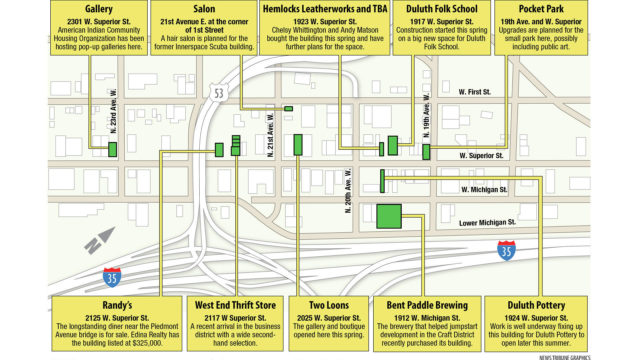Development accelerating in Lincoln Park
When David Dubin visited Duluth in the spring of 2016, he wasn’t too impressed with Lincoln Park’s commercial district. But when he returned last fall, it was another story.
“For some reason it seemed like things were much different. Things were happening,” said Dubin, a Chicago developer who recently purchased the Board of Trade building and who has his eyes on property in Lincoln Park.
Things are moving fast these days in the up-and-coming, self-styled craft district, and there’s more to it than meets the eye. Crafters, traders and teachers are setting up shop, be it at the Duluth Folk School’s new home, a new art gallery and hair salon or new building owners and nascent plans. The neighborhood is fulfilling its destiny the same way it began.
“This neighborhood has made things for 100 years,” said neighborhood booster Shannon Laing with area nonprofit Ecolibrium3. “That’s all it’s ever been.”
Making history
The history of the district could help shape development to come. The city is finalizing a comprehensive look at the commercial area’s history, opening the door to potential historic designations.
“How old are the buildings, what architect, what style, what materials — the survey will prepare a one-page fact sheet on every property,” said Jen Reed Moses, a planner with the city of Duluth. “It’s not exactly an action document. We will know which properties are potentially eligible for historic status.”
A stretch of West Superior Street between 14th and 22nd avenues is proposed as a commercial historic district in a draft version of the document, and three individual properties are being recommended for National Historic Register listing. Six other properties could be given a local historic designation.
A final historic survey could be presented to the Heritage Preservation Commission later this summer.
A historic district wouldn’t tie the hands of developers and property owners, though it could open the door to tax credits, Dubin said. So beyond the intrinsic sheen of a historic listing, such a move could grease the wheels to further speed up Lincoln Park’s redevelopment.
“The issue is in order to make developments feasible, you need to use state and federal historic tax credits,” Dubin said. “If you’re trying to develop an area, it’s a lot easier:”


